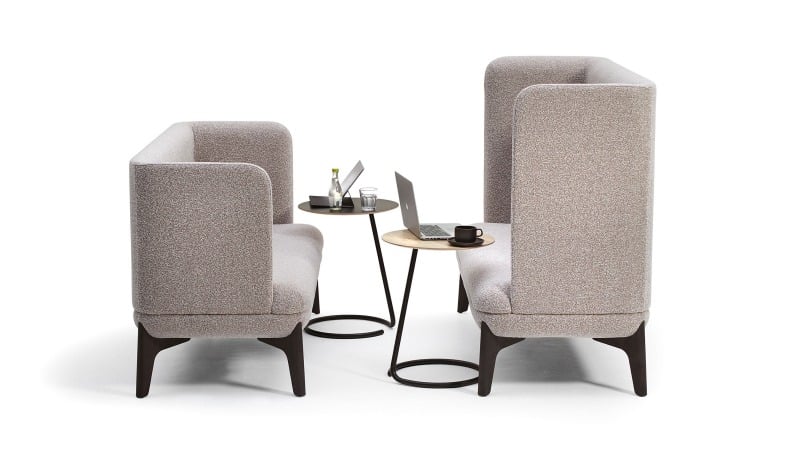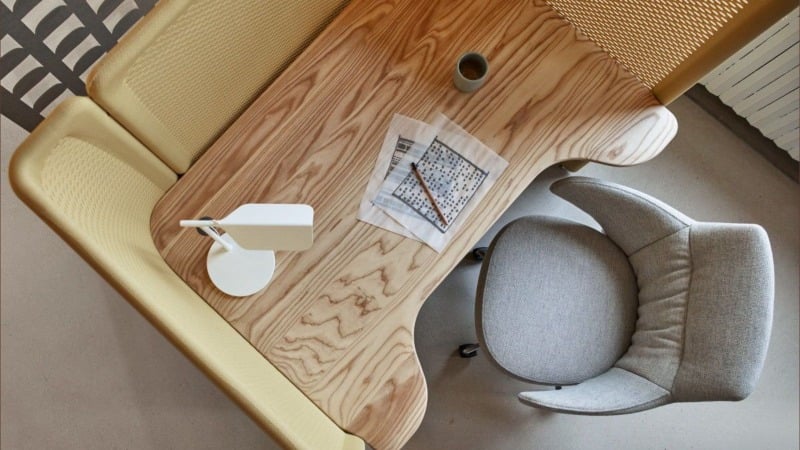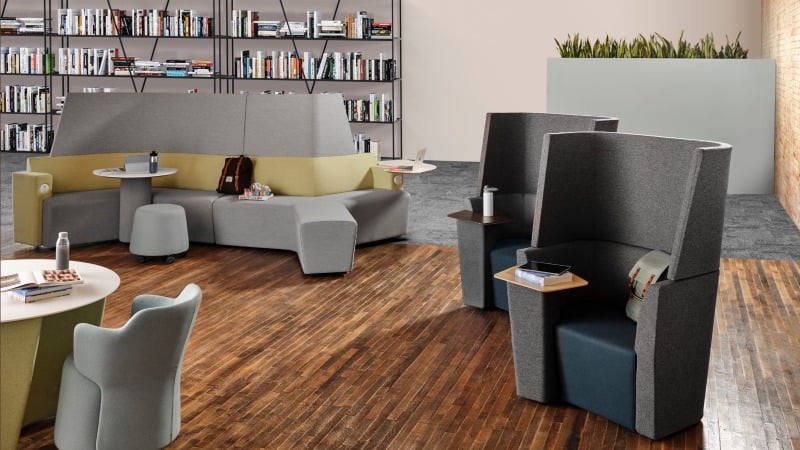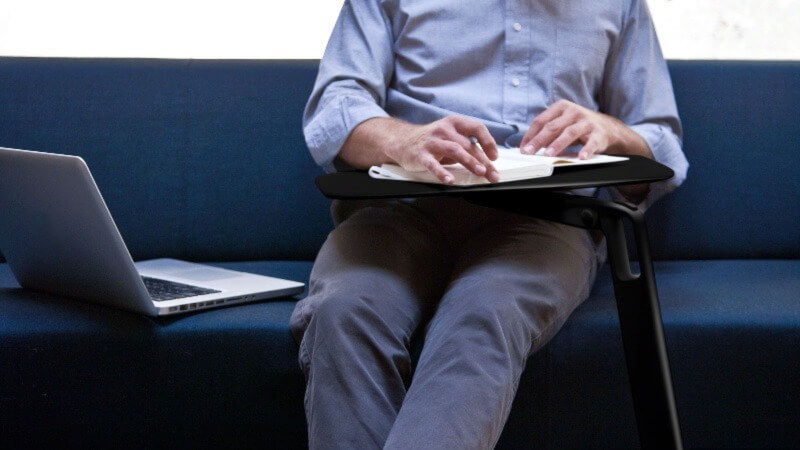Good screen ergonomics are essential for workers’ health and wellbeing, improving engagement, and boosting productivity.
But workers no longer spend 8 hours a day at a desk with fixed and tethered technology. The ratio of workstations to users is going down. And there is an increase in the different types of work modes and different workspaces to support each of these modes throughout the day.
Screen ergonomics now need to be integrated into a wide range of working spaces, not just traditional workstations.
The traditional desk setup
When working at a desk, a computer monitor mounted in the proper position encourages better posture, which helps to prevent neck and back pain, strengthen muscles, and increase blood flow. This means workers are better able to focus, are more engaged, and more productive.
A height-adjustable desk, a good ergonomic chair, and adjustable monitor arms all support users to work comfortably. Large, curved screens or multiple monitor arms enable workers to display more content at one time, view documents side by side, and use several applications simultaneously.
Ergonomics away from the desk
But what happens to screen ergonomics when workers aren’t sitting at a desk?
Steelcase research identified five different modes that workers use across the day: focus, learning, socialising, collaboration, and rejuvenation.
Employers are looking to create workspaces that support workers in each of these modes. And each of these spaces must be designed for optimum ergonomy.
We’re also seeing a different use of technology in the office, with more people working on laptops and tablets. As Lenovo VP, Stefan Engel, puts it:
“In hybrid work, technology devices are our workplaces.”
He argues device ergonomics are key to employees’ daily work experience, and that they need to be able to “seamlessly switch from multiple screens to a mobile monitor to a smartphone.”
Furniture to support screen ergonomics across the workspace
The screen ergonomics that you have in the office should ultimately dictate what you want workers to do in each space.
A typical day may start with answering emails, before a collaboration session in the morning, followed by a few calls, and heads down focused work in the afternoon. The office should provide workers with a range of spaces that encourages each of these activities.
For example, for deeper work or private calls, you may need a more enclosed space that supports one or even no screens. You’re encouraging workers to sit here for an hour or two, so they don’t need the full multi-screen set up, if any at all.
You could create a small nook with a small workstation and a single screen that’s enclosed with visual and acoustic barriers for privacy. Or you may have an armchair with a small table to support a laptop.
For collaboration or meetings where workers can bring their laptops and tablets, you may provide a fixed height table that supports both seating and standing. For more casual meetings, you may bring together several sofas and armchairs, with tablet surfaces and portable tables that can be moved around as needed.
Products that support screen ergonomics
Here are some product examples that will help to support better screen ergonomics in different areas of the workplace:
1. Away From The Desk - Orangebox
The seating system Away From The Desk (AftD) by Orangebox was designed to answer the changing needs of the workplace. It can be configured for individual use, for two, four or six people, and even larger groups, creating a space for personal work and teamwork. The high back offers an ergonomically controlled seating position reflective of a task seat posture, as well as visual and acoustic privacy.
“The aim of this collection was to offer a substantial and credible alternative to desk working.”
2. Massaud chair - Coalesse
The Coalesse Massaud chair is designed for both comfort and connecting with technology. It comes with a swivel tablet surface and is ergonomically designed to support a relaxed incline.
-1.jpg?width=800&name=My%20project-1%20(3)-1.jpg)
3. Lapwing table - Orangebox
The Orangebox Lapwing table is a laptop or occasional table for use in the workplace. The base is structured so that it can be hooked under the leg of a chair to bring it closer to you. It's available in two heights, for use in both formal and informal settings.

4. Free Stand - Coalesse
The Coalesse Free Stand table is height adjustable and the top pivots, allowing you to change the position of the tablet to support a range of activities from working on a laptop to writing in a notebook.
“Free Stand is for almost anyone who has a tablet or laptop and needs a place to land comfortably. It’s ideal for solo work in an office enclave, or collaborating in a conference room.”
5. Brody WorkLounge - Steelcase
The Brody WorkLounge from Steelcase brings ergonomic design to the lounge posture and creates a private shelter for workers within the open plan.
-1.jpg?width=800&name=My%20project%20(26)-1.jpg)
6. Solar - Viccarbe
Solar by Viccarbe is a table with an integrated seat, which rotates according to the user’s needs, making it suitable for both collaboration and privacy.
-1.jpg?width=800&name=My%20project-1%20(5)-1.jpg)
7. Lagunitas Focus Nook - Coalesse
The Lagunitas Focus Nook from Coalesse gives employees' a space for focused work in a traditional work posture.

The centre of all good ergonomic workspaces
You can give people every type of screen possible, a height-adjustable workstation, or a side table they can adjust to suit the activity, and all the bells and whistles. But ultimately, if workers don't have a good, ergonomic chair, they’re not going to be set up right. Whether it’s a task chair or an armchair, it needs to support workers’ comfort and wellbeing, wherever they are in the office.
The Gesture chair by Steelcase, was the first chair to be designed specifically to support how workers interact with space and technology. The arm adjustments enable users to position the chair to support them with any type of device, whether they’re typing on a keyboard or swiping on a tablet.
-1.jpg?width=800&name=My%20project%20(24)-1.jpg)
Whatever mode of work you are trying to support, whether it’s focus, collaboration or casual meetings, having a chair that’s adjustable with good lumbar support, will always be key.
Summary
Employers are looking to change what the office looks like, what it does, and how it functions for users. There’s more focus on creating a range of workspaces that support different modes of work, from individual deep work to big group collaboration and everything in between.
In this new way of working, attention must be paid to how we create spaces that are fit for the user. By creating spaces with varying screen and power options, we can signal to workers how to make the most of the workplace to support all the activities they need to do throughout the day. Whilst at all times, making sure they are supported with a good ergonomic setup.












